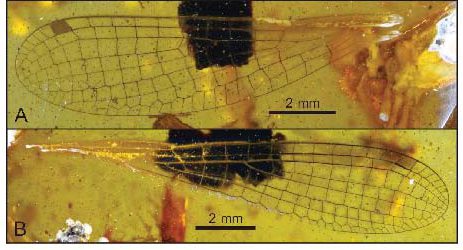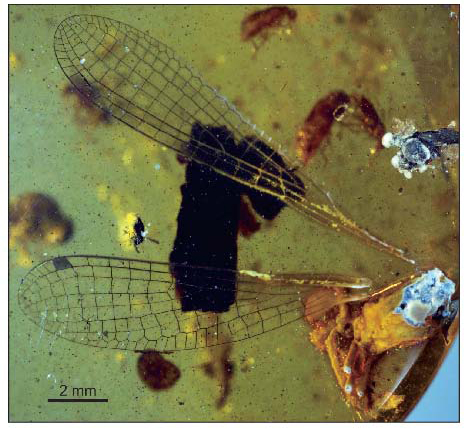New Damselfly Species Honours Sir David Attenborough
Mesosticta davidattenboroughi – Sir David’s Cretaceous Damselfly
Broadcaster, naturalist and all-round good guy, Sir David Attenborough has been honoured yet again by having a newly described species named after him. This time, it is a new species of Cretaceous damselfly discovered in a piece of Burmese amber (burmite). Fossils of insects are extremely rare and the fossil record for this extremely important Class of arthropods has been significantly enriched thanks to the preserved insect remains found in fossilised tree resin.
A Picture of the Holotype Specimen – Mesosticta davidattenboroughi
Picture credit: Journal of Systematic Palaeontology
Sir David Attenborough is Honoured
The remains of this winged insect were discovered in the Hukawng Valley of Kachin Province, northern Myanmar, an area famed for its amber deposits. Details of some remarkable fossils have recently been published, for example, back in 2016 Everything Dinosaur blogged about the discovery of a partial tail from a feathered dinosaur in burmite. As recently as June (June 2017), we wrote about the finding of the remains of a primitive bird, a hatchling that had become entombed and preserved.
To read the article about the discovery of the dinosaur tail: The Tale of a Dinosaur Tail.
For the article on the baby bird fossil: Watch the Birdie! Enantiornithine in Amber.
Mesosticta davidattenboroughi
The full, binomial scientific name for the new species, belonging to a group more commonly known as shadowdamsels, is Mesosticta davidattenboroughi. The researchers decided to name the new species after David Attenborough because of his long-standing appreciation of dragonflies, and to celebrate his recent 90th birthday, which he celebrated in May 2016.
Co-author of the scientific paper, Professor Edmund A. Jarzembowski commented:
“Dragonflies in amber are extremely rare and the recent discoveries by my Chinese colleagues are a new window on the past. It is tradition in taxonomy [the naming of a new species] to contact the person concerned. Sir David was delighted because he is not only interested in the story of amber, but also a president of the British Dragonfly Society.”
The fossil itself is extremely well preserved as it is encased in yellow transparent amber and includes a complete set of wings. With the aid of photo technology, the scientists were able to digitally enhance and build a clear three-dimensional image of the new species, showing that it differed from previously described fossils, Mesosticta had quite stubby, short wings when compared to other Mesozoic species.
Images of the Forewings of Mesosticta davidattenboroughi

Mesosticta davidattenboroughi sp. nov., holotype, NIGP164541. A, photograph of left forewing; B, photograph of right forewing.
Picture credit: Journal of Systematic Palaeontology
Lead author of the scientific paper, Daran Zheng (Nanjing Institute of Geology and Palaeontology, Chinese Academy of Sciences), stated:
“Mesosticta davidattenboroughi is quite unique because we have uncovered a new species and it confirms the previous attribution of Mesosticta to the Platystictidae. It is the first fossil group of modern platystictid damselflies and documents the appearance of Platystictidae as early as middle Cretaceous.”
A Poor Fossil Record
Finding insect remains in amber is not unusual, however, this family of damselflies are very poorly recorded in the fossil record and as a result this discovery from northern Myanmar is especially significant.
Mesosticta davidattenboroughi is just the latest in a long line of animals which have been named in honour of Sir David Attenborough:
Silurian Arthropod honours Sir David Attenborough: Fossil Named after Sir David Attenborough.
Kitten-sized marsupial lion named after Sir David Attenborough: Attenborough’s New Kitty.
The scientific paper: “Mesostictinae subfam. nov., an archaic group of platystictid damselflies (Odonata: Zygoptera) from mid-Cretaceous Burmese amber” by Daran Zheng, Bo Wang, André Nel, Edmund A. Jarzembowski, Haichun Zhang & Su-Chin Chang published in the Journal of Systematic Palaeontology.
Read the full article online: Scientific Paper.
Visit the Everything Dinosaur website: Everything Dinosaur.


